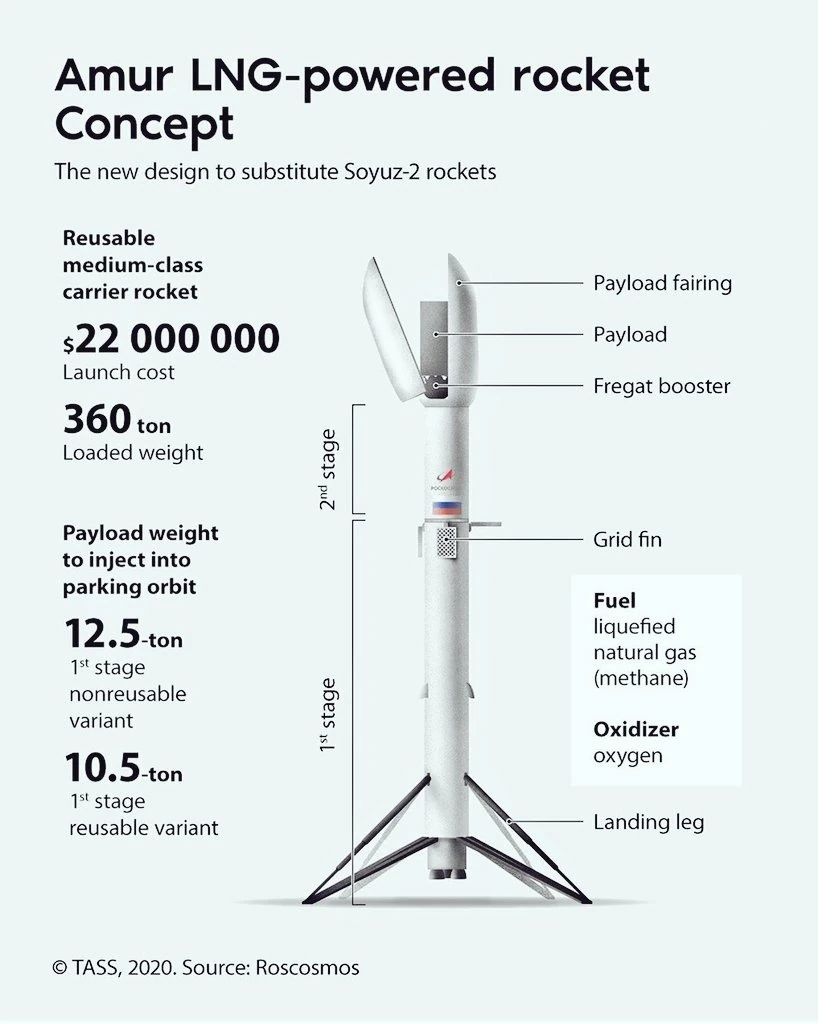Elon Musk, the owner of SpaceX, wrote on the social media platform X in April that he eagerly awaits the demonstration of the Russian reusable rocket “Amur-LNG,” which Roscosmos is developing. LNG stands for Liquefied natural gas.
Earlier, Yuri Borisov, the general director of the Russian space agency Roscosmos, stated that the “Amur-LNG” could be used several times more than SpaceX’s Falcon 9 rocket. Deputy Prime Minister Denis Manturov announced that the first launch of the “Amur-LNG” is scheduled for 2030.
“If the Falcon 9 rocket is typically used no more than ten times, then the first stage using LNG-oxygen fuel can be used at least 50, and possibly more than 100 times. And this directly affects the launch cost,” Borisov said.
As part of the ‘Amur-LNG’ rocket’s development, the construction of its launch pad at the Vostochny Cosmodrome is set to commence in 2026. Currently, the project for the launch complex is in the crucial stage of forming initial data and preparing technical specifications.
Amur-LNG
The design of the medium-class methane rocket Amur-LNG began in 2020. In March 2023, Roscosmos announced the continuation of the reusable methane carrier rocket Amur-LNG development, with technical design planned until 2024. The reusable first stage is expected to be built with the RD-0169 engine. In the reusable variant, the Amur-LNG will be able to launch at least 10.5 tons of payload into low Earth orbit, and in the expendable variant, at least 13.6 tons. The Amur-LNG will replace the currently operational Soyuz-2 rockets.

The launch pad for the Amur-LNG at the Vostochny Cosmodrome is expected to provide 15 launches per year. It may be located next to the “Angara” launch pad. The launch of the reusable carrier rocket Amur-LNG is scheduled for 2030.
Launching the Amur LNG rocket is expected to be between $22 million and $35 Million, which is around two times cheaper than Falcon 9.
Amur-LNG vs. Falcon 9 and Starship
The Amur-LNG and Falcon 9 are two-stage rockets and can be used as expendable or partially reusable, with a returnable first stage. However, directly comparing these launch vehicles raises questions due to different classes and experience in launches and landings.
Amur-LNG
Medium-class carrier rocket,
First stage – 5 methane engines RD-0169A,
Second stage – 1 methane engine RD-0169B-1.
SpaceX Falcon 9
Heavy-class carrier rocket,
First stage – 9 Merlin liquid engines,
Second stage – 1 Merlin Vacuum liquid rocket engine.
With an oxidizer-rich staged combustion cycle, Amur LNG’s RD-0169A engine can generate 100 tons of thrust and has a reusability factor of up to ten. The methane fuel is environmentally friendly and easy to handle. Five of these engines are expected to be configured for the first stage of the Amur-LNG engine.
In contrast, Falcon 9 uses a Kerosene engine. Methane has several advantages over kerosene. One key advantage is that Methane burns without producing soot, so rocket engines can run on it far longer than on kerosene. This is why the Russians say they can send the Amur first stage into space up to 100 times.
Nevertheless, the combustion of liquid methane yields 1.6 times less energy compared to an equivalent volume of kerosene. But Russians say that when cooled to ultra-low temperatures, liquefied gas is compacted enough to use tanks of standard volumes. Interestingly, Space X Starship also uses methane as a fuel, and the company honestly admits that compared to Starship, Falcons are so uncompetitive that with the start of flights of the new carrier, Falcon 9 activities will have to be curtailed.
Starship is expected to cost roughly fifty million dollars to launch in its first phases and several million dollars per launch in its later design refinement stages. Since Starship also uses Methane engines, its launch price will unavoidably drop as proof of its complete reusability grows. It will be interesting to see if the cost falls below $22 million, threatening Amur LNG’s advantage.
But “Amur LNG” will ferry just 10.5 tons of reusable payloads into space, whereas Starship will carry 100 tons at first, with plans to expand the payload later. While the payload launched by Starship will be in a nine-meter-diameter hull with an internal living volume of over 800 cubic meters, those launched by “Amur” will be in a five-meter-diameter fairing. Under no circumstances would “Amur” be competitive in the commercial sector where Starship is present.
The first launch of the Amur-LNG is planned for 2028-2030, while Falcon 9 already has 230 launches and 196 first-stage landings, of which 187 were successful. Additionally, SpaceX is consistently working on increasing the number of reuse cycles for the first stage. For example, one of the Falcon 9 boosters has already completed 20 flights, and SpaceX is currently certifying Falcon 9 boosters for up to 40 flights. Therefore, it is unclear how many reuse cycles the Falcon 9 first stage will have by the time the Amur-LNG launches.
